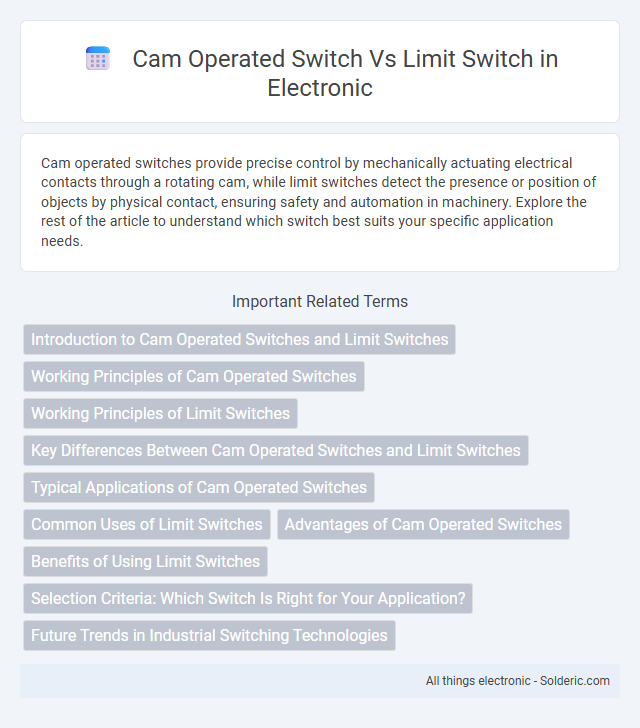Cam operated switches provide precise control by mechanically actuating electrical contacts through a rotating cam, while limit switches detect the presence or position of objects by physical contact, ensuring safety and automation in machinery. Explore the rest of the article to understand which switch best suits your specific application needs.
Comparison Table
| Feature | Cam Operated Switch | Limit Switch |
|---|---|---|
| Operation | Activated by rotating cam mechanism | Activated by direct mechanical contact or movement |
| Purpose | Controls circuits based on cam rotation position | Detects position or presence of an object |
| Actuation Type | Rotary motion | Linear or angular motion |
| Typical Use | Equipment with rotating parts like conveyor systems | Safety interlocks, position detection in machinery |
| Response Speed | Moderate, based on cam rotation speed | Fast, immediate upon object contact |
| Durability | High, suitable for repetitive rotary operations | High, designed for harsh mechanical environments |
| Installation | Requires precise alignment with cam profile | Mounted in path of moving parts or objects |
Introduction to Cam Operated Switches and Limit Switches
Cam operated switches utilize a rotating cam mechanism to control electrical circuits by making or breaking contacts at precise points, ideal for timing and sequencing applications. Limit switches function by detecting physical presence or position of an object through mechanical actuation, commonly used for safety interlocks and equipment control in automation. Both switches provide reliable feedback for industrial control systems but differ in actuation method and application specificity.
Working Principles of Cam Operated Switches
Cam operated switches function by converting rotary or linear mechanical motion into electrical switching actions through a cam mechanism that physically engages and disengages contacts. The cam profile dictates precise switching sequences, allowing for accurate control of electrical circuits in machinery and automation systems. This design provides reliable and repeatable operation in applications requiring coordinated mechanical and electrical interaction.
Working Principles of Limit Switches
Limit switches operate based on mechanical movement triggered by the presence or absence of an object, activating an internal electrical contact to control machinery or processes. A cam-operated switch uses a rotating cam to actuate the switch contacts, converting rotary motion into a precise electrical signal. Your choice depends on whether the application requires direct mechanical detection, as in limit switches, or rotational input sensing, characteristic of cam-operated switches.
Key Differences Between Cam Operated Switches and Limit Switches
Cam operated switches rely on a rotating cam to trigger electrical contacts at predetermined positions, providing precise control over mechanical movements, while limit switches use a physical actuator that is directly engaged by the moving machinery to open or close electrical circuits. Unlike limit switches, cam operated switches offer greater flexibility for applications requiring multiple switching points triggered by different cam profiles. Limit switches are commonly used for safety and position detection in industrial automation, whereas cam operated switches excel in timing and sequencing operations within complex mechanical assemblies.
Typical Applications of Cam Operated Switches
Cam operated switches are commonly used in industrial automation for precise control of machinery by detecting the position of moving parts, such as conveyor systems, packaging machines, and rotating equipment. They provide reliable mechanical actuation to trigger electrical circuits, ideal for motor control, safety interlocks, and sequencing operations. Your selection of cam operated switches ensures accurate and durable performance in environments requiring repeated mechanical cycling.
Common Uses of Limit Switches
Limit switches are commonly used in industrial automation to detect the presence or position of objects, ensuring machinery operates safely and accurately. They serve critical roles in conveyor systems, elevator door controls, and robotic arm positioning, providing reliable on/off signals to control circuits. Your manufacturing process benefits from their precision in monitoring mechanical movements and preventing equipment damage.
Advantages of Cam Operated Switches
Cam operated switches offer precise mechanical control with high repeatability, making them ideal for automated machinery requiring reliable operation. Their robust design ensures durability in harsh industrial environments, reducing maintenance costs compared to limit switches. These switches provide customizable switching angles and positions, enhancing flexibility for complex control applications.
Benefits of Using Limit Switches
Limit switches offer precise position detection and reliable operation in harsh environments, ensuring enhanced safety and efficiency in industrial automation. Their durability and ability to handle high electrical loads reduce maintenance costs and downtime compared to cam operated switches. Integration with automated control systems improves real-time monitoring and process accuracy.
Selection Criteria: Which Switch Is Right for Your Application?
Cam operated switches provide precise control for applications requiring rotational or position-based triggers, ideal for machinery with consistent movement patterns. Limit switches offer reliable end-of-travel detection and are better suited for safety and position sensing in linear or sliding mechanisms. Selecting the right switch depends on your specific operational needs, such as the type of motion, environmental conditions, and required durability.
Future Trends in Industrial Switching Technologies
Cam operated switches and limit switches are evolving with advancements in smart sensor integration and IoT connectivity, enabling predictive maintenance and real-time monitoring in industrial environments. These technologies are increasingly designed to offer enhanced durability, precision, and adaptability to complex automation systems, reducing downtime and operational costs. Your choice of switching technology will benefit from improved data analytics and seamless integration with Industry 4.0 frameworks, driving smarter and more efficient industrial processes.
cam operated switch vs limit switch Infographic

 solderic.com
solderic.com